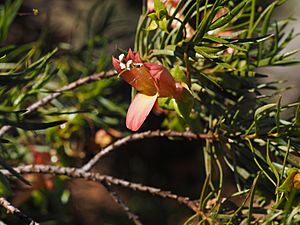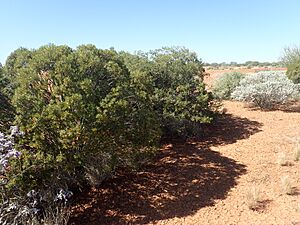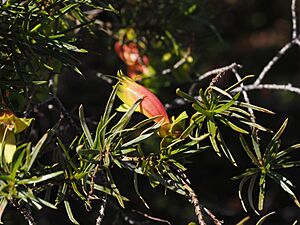Harlequin fuchsia bush facts for kids
Quick facts for kids Harlequin fuchsia bush |
|
|---|---|
 |
|
| Eremophila linearis leaves and flowers | |
| Scientific classification | |
| Genus: |
Eremophila (plant)
|
| Species: |
linearis
|
The Harlequin fuchsia bush, officially known as Eremophila linearis, is a beautiful flowering plant. It belongs to the figwort family and grows only in Western Australia. This shrub has long, shiny, and sticky leaves and branches, along with bright red flowers that make it stand out.
Contents
About the Harlequin Fuchsia Bush
The Harlequin fuchsia bush is a smooth shrub. Its leaves and branches are sticky and shiny because they have a lot of sap, called resin. This plant can grow from about 1 to 4 meters (3 to 13 feet) tall. Its branches are thin, and old leaf parts stay on them.
The leaves grow one after another, and many are grouped together at the ends of the branches. They are usually about 30 to 40 millimeters (1 to 1.5 inches) long and 3 to 5 millimeters (0.1 to 0.2 inches) wide. They are shaped like thin lines or spears and are covered with tiny, raised resin glands.
Flowers and Fruits
The flowers grow one by one where the leaves meet the stem. Each flower sits on a hairy stalk that is usually 10 to 20 millimeters (0.4 to 0.8 inches) long. There are five sticky, overlapping, smooth sepals. These are about 10 to 15 millimeters (0.4 to 0.6 inches) long, but they get bigger after the flower blooms, growing to 15 to 20 millimeters (0.6 to 0.8 inches).
The petals are 25 to 35 millimeters (1 to 1.4 inches) long and are joined at their bottom to form a tube. The top of this tube is bright red to orange-red, while the bottom and inside are yellow. The outside of the petal tube often has scattered hairs, but the inside of the flower's tips is smooth. There are some long hairs inside the tube. The four stamens (the parts that hold pollen) stick out beyond the end of the petal tube.
This plant flowers between March and December. After flowering, it produces dry, egg-shaped or cone-shaped fruits with a pointed end and a papery covering. These fruits are about 7.5 to 13 millimeters (0.3 to 0.5 inches) long.
Plant Name and History
The Harlequin fuchsia bush was first officially described by a botanist named Robert Chinnock in 1980. The second part of its scientific name, linearis, is a Latin word that means "linear" or "shaped like a line." This name describes the plant's long, thin leaves.
Where It Grows
The Harlequin fuchsia bush is found across central Western Australia. You can see it especially between the towns of Meekatharra and Newman. It grows in clay-loam or sandy loam soils, often in low areas, along river flats, and on rocky slopes.
Conservation Status
The Western Australian Government's Department of Parks and Wildlife says that this plant species is "not threatened." This means it is not currently in danger of disappearing.
Growing Harlequin Fuchsia Bush
The Harlequin fuchsia bush is a compact, slow-growing shrub that lives a long time. It has bright green leaves and beautiful red flowers. Because of how it grows, it can be used as a windbreak or a screen in gardens.
It is one of the Eremophila plants that can be grown from seeds, but it's harder to grow from cuttings (small pieces of the plant). If you don't grow it by grafting it onto a Myoporum rootstock (another plant's root system), it needs soil that drains water well. It can grow in full sun or partial shade and only needs water occasionally during long dry periods. It can handle frost, but severe frosts might damage its branches. If this happens, you should remove the damaged branches when the weather gets warmer in spring.
Images for kids




